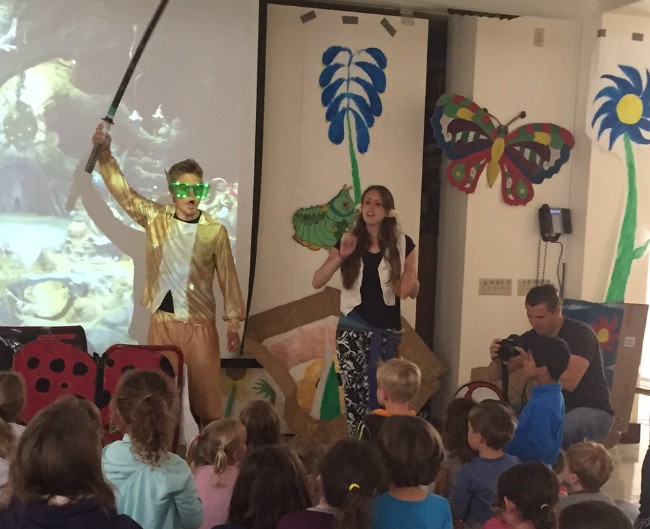San Francisco Summer Camp Makes Learning French a Superpower

You’re a kid. It’s summer. What do you do that’s fun and cool? Attend French Summer Camp, of course. Quoi?
Billed as an “unforgettable summer vacation in French,” the day is filled with music, games, art projects, imaginary adventures, chases and treasure hunts. Each student – from beginner to advanced – is immersed in the French language in a totally supportive environment. Speaking French isn’t forced. It just becomes cool to learn.
The non-profit school Education Française in the Bay Area (EFBA) offers French Summer Camps in four locations in the San Francisco Bay Area. Its goal is to make learning French fun and easy for kindergarten through 5th grade, and pre-teens up to 8th grade. There is actually only one hour of daily class time spent learning French vocabulary, grammar and sentence construction, but the rest of the six-hour day is spent not only learning and using French in a fun, active way, but building student’s confidence in speaking the language.
“We make you believe it is possible to speak French,” said Myriam Da Silva, Summer Program Director at EFBA. “The path to being bilingual is not always natural, and we help children realize it.”
The teachers and directors of the school also believe that learning French in a fun, supportive environment builds character.
“Students are thrown out of their comfort zone, but the collaboration in games and discovery adventures encourages everyone to speak French,” said Gabrielle Durana, President of EFBA. “There is no push to speak French and no punishment if you don’t. With that emphasis on respect, students want to take part, get involved, pick up the language cues and ultimately learn they can succeed and be okay.”
Each week of the four-week camp has a theme, but each day starts with music and dance. My visit to the San Francisco campus was during the third week of camp, and the kids were singing a French song and dancing choreographed moves like a pop video. The energy of both teachers and students was big, with everyone enjoying the dance moves. Then it was snack time, or goûter, followed by stories or activities that use imagination to teach French while keeping to the week’s theme.
The pre-teens were learning about the melting ice caps, and were playing a version of the American game of musical chairs. The ice caps were represented by newspaper pages on the floor, and students and teachers walked around them as music played. When it stopped, they stood on the newspapers to continue playing the game. Pages were removed after each set, so as the paper ice caps melted away, it was progressively harder to stand on the paper at the music pause. Everyone spoke French, but it came easily, and with friendly jargon like “mec” (guy) and lots of laughter when player’s feet couldn’t fit on the last page of the newspaper ice cap.
There was some English spoken by students, but it was mostly asking the definition of a word, which was explained in French.
After the hour-long French lesson, there was creative time based on the week’s theme. This week featured the imaginary world of “Arthur et les Minimoys,” a story of Arthur who shrinks to the insect-size of the tiny Minimoys in his garden to fight the villains trying to unbalance the world’s ecosystems. Two teachers dressed as pointy-eared Minimoys took the children on a video ride to the small world; then another teacher arrived as tall Arthur, who was then changed to small Arthur. Like his legendary namesake, Arthur used a sword pulled from a stone to make things right.
Costumes, cardboard (lots of cut and painted cardboard to create props,) glasses with green lights, yellow pointy ears, a pink-stained jumpsuit and music from the animated 2006 Luc Besson movie all kept students engaged. “A gauche,” said the pointy-eared teacher/Minimoy in the jumpsuit who drove through the Minimoy world via video, and all raised arms angled left. “A droite,” he said, and all arms shifted right.
When Arthur arrived, he wore glasses outlined in bright green lights. He was “shrunk,” and then pulled out his sword and talked about saving the ecosystem. All was in French, and whether everyone understood the French or not, they understood the gist of what was said.
“We teach through playing,” said Da Silva. “It is a technique called jeu de l’oie, or game of the goose.”
Vinçent Minquoy, Marketing and Communications Director explained the technique further: “The goal is to break the ice, to make students confident on their way to learning using fun tools. This creates the potential motivation to learn French. It’s vivre ensemble.”
EFBA has even caught the attention and support of Pauline Carmona, Consule of France in San Francisco and EFBA board member. “EFBA is a tremendous association,” she said. “I want to pay tribute to its team, whose dedication and dynamism are central to the success of the project. At the service of the French community, and of all the parents who want their children to open up to a new culture, EFBA is a key contributor to the promotion of French language and culture in the Bay Area.”
The rest of the day was déjeuner and outdoor activities that also matched the week’s theme. There were textbooks and vocabulary lists, of course, but the fun, play-based learning created big smiles from the kids, confidence in speaking another language and, according to Durana, a 100 percent renewal rate for next summer’s program.
As Virgule, EBFA’s mascot says, “We speak French. What’s your superpower?”
Martha Sessums is the France Today Ambassador for San Francisco
Share to: Facebook Twitter LinkedIn Email
More in San Francisco
Leave a reply
Your email address will not be published. Required fields are marked *



